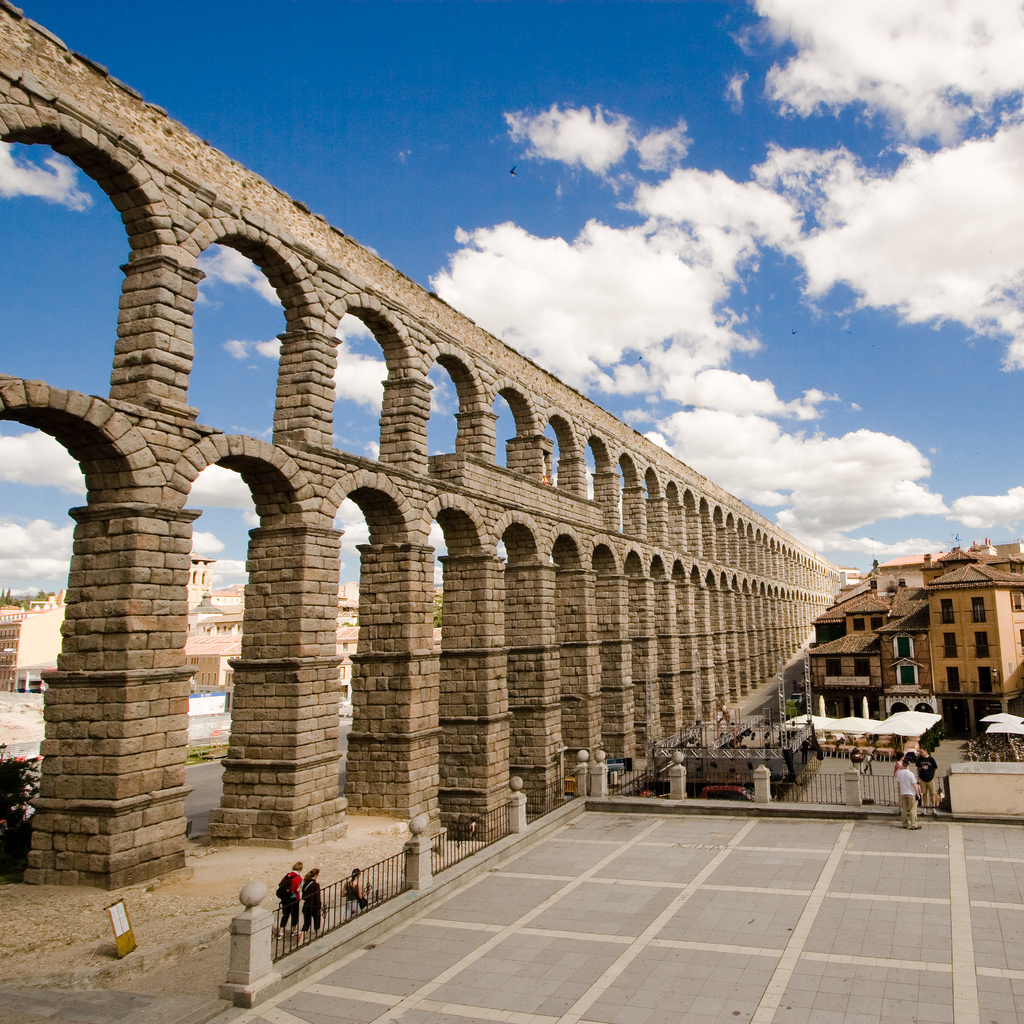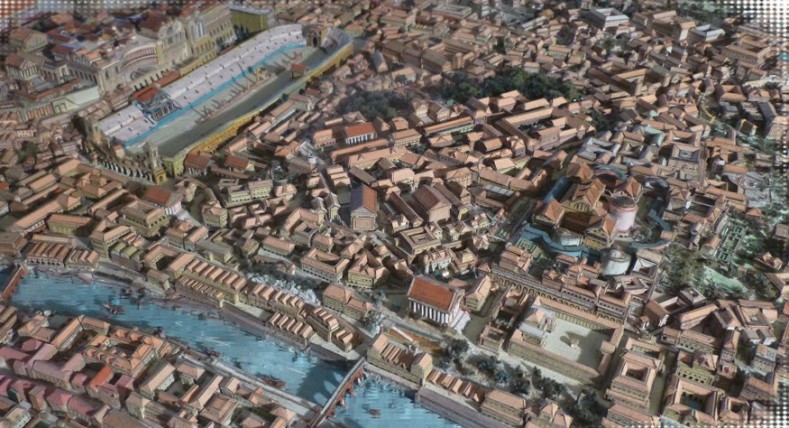In this journey, you will read about how Perseus battles a sea-monster to save Andromeda. Along the way, we’ll explore some of the sites on the Aventine Hill and review the Demonstrative Pronouns and Adjectives: hic, ille, and is; and the Personal Pronouns: ego, tū, nōs, and vōs.
A. Let’s start by diving into the next chapter of our exciting fābula dē Perseō: Mōnstrum marīnum et hostia hūmāna (“The Sea Monster and the Human Sacrifice”).
Post haec Perseus in fīnīs Aethiopum vēnit. Ibi Cēpheus quīdam illō tempore rēgnābat. Hic Neptūnum, maris deum, ōlim offenderat; Neptūnus autem mōnstrum saevissimum mīserat. Hoc cottīdiē ē marī veniēbat et hominēs dēvorābat. Ob hanc causam timor animōs omnium occupāverat. Cēpheus igitur ōrāculum deī Hammōnis cōnsuluit, atque hic deus iussit Cēpheum fīliam mōnstrō trādere. Ēius autem fīlia, nōmine Andromeda, virgō fōrmōsissima erat. Cēpheus ubi haec crūdēlia audīvit, magnum dolōrem percēpit. Volēbat tamen cīvīs suōs ē tantō perīculō extrahere, atque ob eam causam imperāta Hammōnis facere cōnstituit.
Tum rēx diem certam dīxit et omnia parāvit. Ubi ea diēs vēnit, Cēpheus Andromedam ad id lītus dūxit, et prō oculīs omnium ad rūpem eam adligāvit. Omnēs fātum ēius dēplōrābant, nec lacrimās tenēbant. At subitō, dum mōnstrum exspectant, Perseus accurrit; et ubi lacrimās vīdit, causam dolōris quaerit. Illī omnia eī expōnunt et puellam dēmōnstrant. Subitō clāmōrem terribilem audiunt; simul mōnstrum horribilī formā procul cōnspiciunt. Ēius forma timōrem maximum omnibus iniēcit. Mōnstrum magnā celeritāte ad lītus contendit, iamque ad locum appropinquābat ubi puella stābat.
B. Always read and re-read until you have a good sense of the story.
Check your understanding by completing this brief comprehension quiz in Cerego. If you any of the answers eluded you, be sure to return and re-read the story and try again!
C. Demonstratives let us differentiate between “this” and “that”. Invest 5 minutes reviewing the strong demonstrative ille, illa, illud or “that”.
You can review this and more about this and related pronouns on Allen & Greenough §146.
D. Practice the forms of ille, illa, illud.
1. First practice the paradigm of ille, illa, illud on Magistrula.com.
2. Review the forms of ille, illa, illud on Quizlet.com until you are confident that you can recognize the case, number, and gender of any form of this demonstrative pronoun.
E. Now that you can say “that”, let’s review how to say “this”!
1. Invest 5 minutes reviewing the strong demonstrative hic, haec, hoc or “this”.
2. Practice the forms of hic, haec, hoc on Quizlet.com until you are confident that you can recognize the case, number, and gender of any form of this demonstrative pronoun.
3. Demonstrate that you know this and that about Latin strong demonstratives by mastering this activity on Cerego.
F. Now that you have reviewed your strong demonstratives, let’s revisit them in context.
1. Re-read the Mōnstrum marīnum chapter of fābula dē Perseō, with special attention to the forms of his and ille.
Post haec Perseus in fīnīs Aethiopum vēnit. Ibi Cēpheus quīdam illō tempore rēgnābat. Hic Neptūnum, maris deum, ōlim offenderat; Neptūnus autem mōnstrum saevissimum mīserat. Hoc cottīdiē ē marī veniēbat et hominēs dēvorābat. Ob hanc causam timor animōs omnium occupāverat. Cēpheus igitur ōrāculum deī Hammōnis cōnsuluit, atque hic deus iussit Cēpheum fīliam mōnstrō trādere. Ēius autem fīlia, nōmine Andromeda, virgō fōrmōsissima erat. Cēpheus ubi haec crūdēlia audīvit, magnum dolōrem percēpit. Volēbat tamen cīvīs suōs ē tantō perīculō extrahere, atque ob eam causam imperāta Hammōnis facere cōnstituit.
2. Complete this short activity on Cerego in which you will identify the correct form of the strong demonstrative in the paragraph.
G. BONUS KNOWLEDGE! Note that your review of hic, ille, and is has also prepared you to recognize the forms of the demonstrative iste, ista, istud (“that (of yours)” or (“that (yonder)”); īdem, eadem, idem (“the same”); the intensive demonstrative ipse, ipsa, ipsum (“him/her/it self”).
You can review paradigms and more about these pronouns on Allen & Greenough §146 and see a short video about iste, ista, istud on LatinTutorial.
G. You’ve earned a rest in the shade of Rome’s first aquaduct, the Aqua Appia.
Constructed in 312 BC by the co-censors Gaius Plautius Venox and Appius Claudius Caecus, the Appia led more than 70,000 cubic meters of water into Rome per day. Most of its mile length ran below ground before approaching the city on the spectacular bridge shown above.
H. Latin also has a weak demonstrative — is, ea, id — which instead of differentiating “this” from “that” can show that someone or this is “the” thing instead of just “a” thing. But most commonly, is ea id is used as the Third Person Pronoun (“he/him, she/her, it, they/them”).
1. Invest 6 minutes reviewing the basics of this very useful and common word.
2. Now practice paradigms of hic and ille and is on Magistrula.com.
3. Pratice the forms of is, ea, id on Quizlet. You can try your hand at identifying ambiguous forms with this Quizlet set.
I. Let’s briefly review the forms of is, ea, id in context.
1. Re-read the Hostia hūmāna chapter of fābula dē Perseō, with special attention to forms of is, ea, id.
Tum rēx diem certam dīxit et omnia parāvit. Ubi ea diēs vēnit, Cēpheus Andromedam ad id lītus dūxit, et prō oculīs omnium ad rūpem eam adligāvit. Omnēs fātum ēius dēplōrābant, nec lacrimās tenēbant. At subitō, dum mōnstrum exspectant, Perseus accurrit; et ubi lacrimās vīdit, causam dolōris quaerit. Illī omnia eī expōnunt et puellam dēmōnstrant. Subitō clāmōrem terribilem audiunt; simul mōnstrum horribilī formā procul cōnspiciunt. Ēius forma timōrem maximum omnibus iniēcit. Mōnstrum magnā celeritāte ad lītus contendit, iamque ad locum appropinquābat ubi puella stābat.
2. Complete this short activity on Cerego in which you will identify the correct form of the weak demonstrative in this paragraph.
J. Nicely done! You’ve earned a rest in one of the many tabernae (“pubs”) that line the streets below the apartment buildings on the Aventine.
K. The final part of our journey around the Aventine will see us reviewing the Personal Pronouns for the first person (ego, nōs) and second person (tū, vōs)
1. Invest 5 minutes reviewing Personal Pronouns.
You can find more about Personal Pronouns in Allen & Greenough §142 (personal pronouns), §143 (ego and tū declined), §295 (personal pronoun constructions)
2. On Magistrula, practice the paradigm for ego.
3. On Magistrula, practice the paradigm for tu.
4. On Magistrula, practice the paradigm for nōs.
5. On Magistrula, practice the paradigm for vōs.
L. Show me that you are the master of personal pronouns by completing these activities.
1. Complete this short comprehension activity on Cerego to show that you know the basics of personal pronouns.
2. Practice the forms of the personal pronouns on Magistrula.com until you are very confident that you can translate any form of the personal pronoun that comes your way.
M. Nicely done! Take a break and check out a race in the Circus Maximus before you wrap up your review of the demonstratives and pronouns.
The Circus Maximus was situated in the hollow between the Aventine and Palatine hills. Among the largest stadia ever built, it could host more than 150,000 Romans for pulse-pounding chariot races, famously recreated for the film, Ben-Hur.
N. Identify the correct form of all the demonstratives and personal pronouns in our fābula.
O. Now you are read to re-read our fābula with special attention to Demonstratives and Personal Pronouns.
Multī fābulās dē Perseō nārrant. Perseus fīlius erat Iovis, maximī deōrum; avus ēius est Ācrisius. Sed Ācrisius volēbat Perseum nepōtem suum necāre; nam propter ōrāculum puerum timēbat. Comprehendit igitur Perseum adhūc īnfantem, et cum mātre in arcā ligneā inclūsit. Tum arcam ipsam in mare coniēcit. Danaē, Perseī māter, magnopere timēbat; tempestās enim magna mare turbābat. Perseus autem in gremiō mātris dormiēbat.
Iuppiter tamen haec omnia vīdit, et fīlium suum servāre cōnstituit. Tranquillum igitur fēcit mare, et arcam ad īnsulam Serīphum perdūxit. Hūius īnsulae Polydectēs tum rēx erat. Postquam mare tranquillum arcam ligneam cum fīliō Iovis ad lītus mōverat, Danaē in harēnā pācem capiēbat. Post breve tempus piscātor mātrem et infantem invēnit, et duōs ad domum rēgis Polydectis dūxit. Ille mātrem et puerum benignē excēpit, et iīs sēdem tūtam in fīnibus suīs dedit. Danaē hoc dōnum libenter accēpit, et prō tantō beneficiō rēgī grātiās ēgit.
Perseus igitur multōs annōs ibi habitābat, et cum mātre suā vītam beātam agēbat. At Polydectēs Danaēn magnopere amābat, atque eam in mātrimōnium dūcere volēbat. Hoc tamen cōnsilium Perseō minimē grātum erat. Polydectēs igitur Perseum dīmittere cōnstituit. Tum iuvenem ad sē vocāvit et haec dīxit: “Turpe est hanc ignāvam vītam agere; iam dūdum tū adulēscēns es. Quō usque hīc manēbis? Tempus est arma capere et virtūtem praestāre. Hinc abī, et caput Medūsae mihi refer.”
Perseus ubi haec audīvit, ex īnsulā discessit, et postquam ad terram vēnit, Medūsam quaesīvit. Diū frūstrā quaerēbat; namque nātūram locī ignōrābat. Tandem Apollō et Minerva viam dēmōnstrāvērunt. Prīmum ad Graeās, sorōrēs Medūsae, pervēnit. Ab hīs tālāria et galeam magicam accēpit. Apollō autem et Minerva falcem et speculum dedērunt. Tum postquam tālāria pedibus induit, in āera ascendit. Diū per āera volābat; tandem tamen ad eum locum vēnit ubi Medūsā cum cēterīs Gorgōnibus habitābat. Gorgōnēs autem mōnstra erant formā horribilī; Anguēs enim capita Gorgōnum omnīnō contēxerant. Aenī etiam erant manūs Gorgōnum.
difficillimum erat caput Gorgonis abscīdere; ēius enim forma hominēs in saxum vertēbat. Propter causam Minerva speculum Perseō dederat. Ille igitur tergum vertit, et in speculum īnspiciēbat; hōc modō ad locum vēnit ubi Medūsa dormiēbat. Tum falce suā caput ēius ūnā plāgā abscīdit. Clāmor cēterās Gorgōnum statim ē somnō excitāvērunt, et ubi mortem vīdērunt, īra magna omnēs commōvit. Arma rapuērunt, et Perseum occīdere volēbant. Ille autem dum fūgit, galeam magicam induit; et ubi hoc fēcit, statim ē oculīs eārum ēvāsit.
Post haec Perseus in fīnīs Aethiopum vēnit. Ibi Cēpheus quīdam illō tempore rēgnābat. Hic Neptūnum, maris deum, ōlim offenderat; Neptūnus autem mōnstrum saevissimum mīserat. Hoc cottīdiē ē marī veniēbat et hominēs dēvorābat. Ob hanc causam timor animōs omnium occupāverat. Cēpheus igitur ōrāculum deī Hammōnis cōnsuluit, atque hic deus iussit Cēpheum fīliam mōnstrō trādere. Ēius autem fīlia, nōmine Andromeda, virgō fōrmōsissima erat. Cēpheus ubi haec crūdēlia audīvit, magnum dolōrem percēpit. Volēbat tamen cīvīs suōs ē tantō perīculō extrahere, atque ob eam causam imperāta Hammōnis facere cōnstituit.
Tum rēx diem certam dīxit et omnia parāvit. Ubi ea diēs vēnit, Cēpheus Andromedam ad id lītus dūxit, et prō oculīs omnium ad rūpem eam adligāvit. Omnēs fātum ēius dēplōrābant, nec lacrimās tenēbant. At subitō, dum mōnstrum exspectant, Perseus accurrit; et ubi lacrimās vīdit, causam dolōris quaerit. Illī omnia eī expōnunt et puellam dēmōnstrant. Subitō clāmōrem terribilem audiunt; simul mōnstrum horribilī formā procul cōnspiciunt. Ēius forma timōrem maximum omnibus iniēcit. Mōnstrum magnā celeritāte ad lītus contendit, iamque ad locum appropinquābat ubi puella stābat.
Z. Once you have successfully completed these activities, congratulations! You have taken the next step on your (re)exploration of Latin — and Rome — by Scaling the Aventine Hill.
Other Resources and Practice on Third Declension Nouns and Adjectives
- Magistrula.com: [Paradigm of ille, illa, illud] [Paradigms of hic and ille and is] [Paradigm for ego] [Paradigm for tu] [Paradigm for nōs] [Paradigm for vōs]
- Latintutorial.com: [ille, illa, illud] [hic, haec, hoc] [is, ea, id] [Personal Pronouns]
- Quizlet.com: [Morphology of ille, illa, illud] [Morphology of hic, haec, hoc]
- Cerego.com: [Reading Comprehension] [Demonstratives Comprehension] [Strong Demonstratives in Fābula] [Weak Demonstratives in Fābula] [Personal Pronouns Comprehension]





